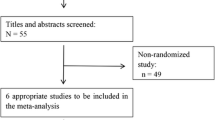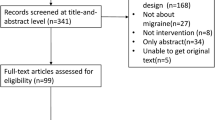Abstract
Objective
To assess the efficacy and safety of high-frequency repetitive transcranial magnetic stimulation in the prevention or treatment of migraine by conducting a pooled analysis of relevant randomized controlled trials.
Methods
The PubMed, Embase, Cochrane, OVID, SCOPUS, Web of Science, and clinicaltrials.gov databases were systematically searched for randomized controlled trials (RCTs) comparing high-frequency rTMS and sham stimulation for the prevention or treatment of migraine. A meta-analysis of relevant outcome measures was performed using RevMan 5.3 software.
Results
Eight RCTs with a total of 384 patients were included. A total of 23 patients dropped out, and thus, 361 patients were ultimately included for analysis. The high-frequency rTMS group had a lower frequency of attacks than the sham group (MD = − 5.10; 95% CI: − 8.10, − 2.09; P = 0.0009). The rTMS group has less intense headaches than the sham group (SMD = − 0.74; 95% CI − 1.04, − 0.44; P < 0.00001). High-frequency rTMS improved patient disability (SMD = − 0.45; 95% CI − 0.75, − 0.16; P = 0.003). High-frequency rTMS led to no advantage in reducing the number of abortive medications (MD = − 1.10; 95% CI − 3.28, 1.08; P = 0.32), but it increased the occurrence of adverse events (RR = 1.69; 95% CI 1.09, 2.64; P = 0.02).
Conclusions
High-frequency rTMS reduces the frequency of attacks and headache intensity in migraine patients and improves the patient’s disability, but it also increases adverse events.








Similar content being viewed by others
Data availability
The datasets used and/or analysed during the current study are available from the corresponding author on reasonable request.
References
Alkahtani RF, Alrumaih SS, Algezlan SS, Almutairi RR, Alturki BA, Alanazi RM, Alateeq FA (2022) The impact of migraine disease on work productivity and quality of life among the adults in Riyadh Saudi Arabia. Cureus. https://doi.org/10.7759/cureus.27733
Agostoni EC, Longoni M (2018) Migraine and cerebrovascular disease: still a dangerous connection? Neurol Sci. https://doi.org/10.1007/s10072-018-3429-8
Abdullah M, Qaiser S, Malik A, Chaudhry M, Fatima T, Malik A, Iqbal N (2020) Comparison between menstrual migraine and menstrual-unrelated migraine in women attending gynecology clinics. Cureus. https://doi.org/10.7759/cureus.10976
Pescador RM, De Jesus O. (2022). Migraine Headache.
Grazzi L (2022) Mindfulness and other behavioral approaches. Neurol Sci. https://doi.org/10.1007/s10072-022-06155-z
Mayans L, Walling A (2018) Acute migraine headache: treatment strategies. Am Fam Physician 97(4):243–251
Whyte CA, Tepper SJ (2009) Adverse effects of medications commonly used in the treatment of migraine. Expert Rev Neurother. https://doi.org/10.1586/ern.09.47
Thorlund K, Toor K, Wu P, Chan K, Druyts E, Ramos E, Bhambri R, Donnet A, Stark R, Goadsby PJ (2017) Comparative tolerability of treatments for acute migraine: a network meta-analysis. Cephalalgia. https://doi.org/10.1177/0333102416660552
Hovaguimian A, Roth J (2022) Management of chronic migraine. BMJ. https://doi.org/10.1136/bmj-2021-067670
Galhardoni R, Correia GS, Araujo H, Yeng LT, Fernandes DT, Kaziyama HH, Marcolin MA, Bouhassira D, Teixeira MJ, de Andrade DC (2015) Repetitive transcranial magnetic stimulation in chronic pain: a review of the literature. Arch Phys Med Rehabil. https://doi.org/10.1016/j.apmr.2014.11.010
Rossi S, Hallett M, Rossini PM, Pascual-Leone A (2009) Safety, ethical considerations, and application guidelines for the use of transcranial magnetic stimulation in clinical practice and research. Clin Neurophysiol. https://doi.org/10.1016/j.clinph.2009.08.016
Barker AT, Jalinous R, Freeston IL (1985) Non-invasive magnetic stimulation of human motor cortex. Lancet. https://doi.org/10.1016/s0140-6736(85)92413-4
Eldaief MC, Press DZ, Pascual-Leone A (2013) Transcranial magnetic stimulation in neurology: A review of established and prospective applications. Neurol Clin Pract. https://doi.org/10.1212/01.CPJ.0000436213.11132.8e
Aleman A (2013) Use of repetitive transcranial magnetic stimulation for treatment in psychiatry. Clin Psychopharmacol Neurosci. https://doi.org/10.9758/cpn.2013.11.2.53
Zis P, Shafique F, Hadjivassiliou M, Blackburn D, Venneri A, Iliodromiti S, Mitsikostas DD, Sarrigiannis PG (2020) Safety, tolerability, and nocebo phenomena during transcranial magnetic stimulation: a systematic review and meta-analysis of placebo-controlled clinical trials. Neuromodulation. https://doi.org/10.1111/ner.12946
Du J, Yang F, Hu J, Hu J, Xu Q, Cong N, Zhang Q, Liu L, Mantini D, Zhang Z, Lu G, Liu X (2019) Effects of high- and low-frequency repetitive transcranial magnetic stimulation on motor recovery in early stroke patients: Evidence from a randomized controlled trial with clinical, neurophysiological and functional imaging assessments. Neuroimage Clin. https://doi.org/10.1016/j.nicl.2018.101620
Saltychev M, Juhola J (2022) Effectiveness of high-frequency repetitive transcranial magnetic stimulation in migraine: a systematic review and meta-analysis. Am J Phys Med Rehabil. https://doi.org/10.1097/PHM.0000000000001953
Cumpston MS, McKenzie JE, Welch VA, Brennan SE (2022) Strengthening systematic reviews in public health: guidance in the Cochrane Handbook for Systematic Reviews of Interventions, 2nd edn. J Public Health Oxf
Randa A, Tamer E, Samia A, Mahmoud H, Nahed SE, Salma H, Shouman S, Shouman M (2020) The role of left prefrontal transcranial magnetic stimulation in episodic migraine prophylaxis. Egyptian J Neuro Psy Neurosurg. https://doi.org/10.1186/s41983-019-0140-5
Misra UK, Kalita J, Bhoi SK (2013) High-rate repetitive transcranial magnetic stimulation in migraine prophylaxis: a randomized, placebo-controlled study. J Neuro. https://doi.org/10.1007/s00415-013-7072-2
Conforto AB, Amaro E, Goncalves AL, Mercante JP, Guendler VZ, Ferreira JR, Kirschner CC, Peres MF (2014) Randomized, proof-of-principle clinical trial of active transcranial magnetic stimulation in chronic migraine. Cephalalgia. https://doi.org/10.1177/0333102413515340
Brighina F, Piazza A, Vitello G, Aloisio A, Palermo A, Daniele O, Fierro B (2004) rTMS of the prefrontal cortex in the treatment of chronic migraine: a pilot study. J Neurol Sci. https://doi.org/10.1016/j.jns.2004.08.008
Todorov V, Bogdanova D, Tonchev P, Milanov I (2020) Repetitive transcranial magnetic stimulation over two target areas, sham stimulation and topiramate in the treatment of chronic migraine. Comptes Rendus del Academie Bulgare Des Sciences. https://doi.org/10.7546/CRABS.2020.09.15
Kumar A, Mattoo B, Bhatia R, Kumaran S, Bhatia R (2021) Neuronavigation based 10 sessions of repetitive transcranial magnetic stimulation therapy in chronic migraine: an exploratory study. Neurol Sci. https://doi.org/10.1007/s10072-020-04505-3
Leahu P, Bange M, Ciolac D, Scheiter S, Matei A, Gonzalez-Escamilla G, Chirumamilla VC, Groppa SA, Muthuramn M, Groppa S (2021) Increased migraine-free intervals with multifocal repetitive transcranial magnetic stimulation. Brain Stimul. https://doi.org/10.1016/j.brs.2021.10.383
Shah J, Dhull P, Somasekharan M, Soni R, Gupta S (2022) Repetitive transcranial magnetic stimulation for prophylactive treatment of chronic migraine: a randomised, single-blind, parallel-group, sham-controlled trial. Neurol Asia. https://doi.org/10.54029/2022mau
Goadsby PJ, Holland PR, Martins-Oliveira M, Hoffmann J, Schankin C, Akerman S (2017) Pathophysiology of migraine: a disorder of sensory processing. Physiol Rev. https://doi.org/10.1152/physrev.00034.2015
Ashina M, Terwindt GM, Al-Karagholi MA, de Boer I, Lee MJ, Hay DL, Chulte LH, Hadjikhani N, Sinclair AJ, Ashina H, Schwedt TJ, Goadsby PJ (2021) Migraine: disease characterisation, biomarkers, and precision medicine. Lancet. https://doi.org/10.1016/S0140-6736(20)32162-0
Borkum JM (2021) Brain energy deficit as a source of oxidative stress in migraine: a molecular basis for migraine susceptibility. Neurochem Res. https://doi.org/10.1007/s11064-021-03335-9
Tanha HM, Sathyanarayanan A, Nyholt DR (2021) Genetic overlap and causality between blood metabolites and migraine. Am J Hum Genet. https://doi.org/10.1016/j.ajhg.2021.09.011
Siebner HR, Funke K, Aberra AS, Antal A, Bestmann S, Chen R, Classen J, Davare M, Di Lazzaro V, Fox PT, Hallett M, Karabanov AN, Kesselheim J, Beck MM, Koch G, Liebetanz D, Meunier S, Miniussi C, Paulus W, Peterchev AV, Popa T, Ridding MC, Thielscher A, Ziemann U, Rothwell JC, Ugawa Y (2022) Transcranial magnetic stimulation of the brain: what is stimulated?—a consensus and critical position paper. Clin Neurophysiol. https://doi.org/10.1016/j.clinph.2022.04.022
Stilling JM, Monchi O, Amoozegar F, Debert CT (2019) Transcranial magnetic and direct current stimulation (tms/tdcs) for the treatment of headache: a systematic review. Headache. https://doi.org/10.1111/head.13479
Lefaucheur JP, André-Obadia N, Antal A, Ayache SS, Baeken C, Benninger DH, Cantello RM, Cincotta M, de Carvalho M, De Ridder D, Devanne H, Di Lazzaro V, Filipović SR, Hummel FC, Jääskeläinen SK, Kimiskidis VK, Koch G, Langguth B, Nyffeler T, Oliviero A, Padberg F, Poulet E, Rossi S, Rossini PM, Rothwell JC, Schönfeldt-Lecuona C, Siebner HR, Slotema CW, Stagg CJ, Valls-Sole J, Ziemann U, Paulus W, Garcia-Larrea L (2014) Evidence-based guidelines on the therapeutic use of repetitive transcranial magnetic stimulation (rTMS). Clin Neurophysiol. https://doi.org/10.1016/j.clinph.2014.05.021
Lorenz J, Minoshima S, Casey KL (2003) Keeping pain out of mind: the role of the dorsolateral prefrontal cortex in pain modulation. Brain. https://doi.org/10.1093/brain/awg102
Chail A, Saini RK, Bhat PS, Srivastava K, Chauhan V (2018) Transcranial magnetic stimulation: a review of its evolution and current applications. Ind Psychiatry J. https://doi.org/10.4103/ipj.ipj_88_18
Godfrey KEM, Muthukumaraswamy SD, Stinear CM, Hoeh N (2021) Effect of rTMS on GABA and glutamate levels in treatment-resistant depression: an MR spectroscopy study. Psychiatry Res Neuroimaging. https://doi.org/10.1016/j.pscychresns.2021.111377
Ahn HM, Kim SE, Kim SH (2013) The effects of high-frequency rTMS over the left dorsolateral prefrontal cortex on reward responsiveness. Brain. https://doi.org/10.1016/j.brs.2012.05.013
Andreou AP, Holland PR, Akerman S, Summ O, Fredrick J, Goadsby PJ (2016) Transcranial magnetic stimulation and potential cortical and trigeminothalamic mechanisms in migraine. Brain. https://doi.org/10.1093/brain/aww118
Sahu AK, Sinha VK, Goyal N (2019) Effect of adjunctive intermittent theta-burst repetitive transcranial magnetic stimulation as a prophylactic treatment in migraine patients: a double-blind sham-controlled study. Indian J Psychiatry. https://doi.org/10.4103/psychiatry.IndianJPsychiatry_472_18
Deng ZD, Lisanby SH, Peterchev AV (2013) Electric field depth-focality tradeoff in transcranial magnetic stimulation: simulation comparison of 50 coil designs. Brain Stimul. https://doi.org/10.1016/j.brs.2012.02.005
Kolbe R, Aytulun A, Müller AK, Ringelstein M, Aktas O, Schnitzler A, Hartung HP, Groiss SJ, Albrecht P (2020) Occipital repetitive transcranial magnetic stimulation does not affect multifocal visual evoked potentials. BMC Neurosci. https://doi.org/10.1186/s12868-020-00600-5
Kumar S, Singh S, Kumar N, Verma R (2018) The effects of repetitive transcranial magnetic stimulation at dorsolateral prefrontal cortex in the treatment of migraine comorbid with depression: a retrospective open study. Clin Psychopharmacol Neurosci. https://doi.org/10.9758/cpn.2018.16.1.62
Wang J, Deng XP, Wu YY, Li XL, Feng ZJ, Wang HX, Jing Y, Zhao N, Zang YF, Zhang J (2020) High-frequency rTMS of the motor cortex modulates cerebellar and widespread activity as revealed by SVM. Front Neurosci. https://doi.org/10.3389/fnins.2020.00186
Teepker M, Hötzel J, Timmesfeld N, Reis J, Mylius V, Haag A, Oertel WH, Rosenow F, Schepelmann K (2010) Low-frequency rTMS of the vertex in the prophylactic treatment of migraine. Cephalalgia. https://doi.org/10.1111/j.1468-2982.2009.01911.x
Krishnan C, Santos L, Peterson MD, Ehinger M (2015) Safety of noninvasive brain stimulation in children and adolescents. Brain Stimul. https://doi.org/10.1016/j.brs.2014.10.012
Vukovic CV, Jensen RH (2019) Neurostimulation for the treatment of chronic migraine and cluster headache. Acta Neurol Scand. https://doi.org/10.1111/ane.13034
Macedo A, Baños JE, Farré M (2008) Placebo response in the prophylaxis of migraine: a meta-analysis. Eur J Pain. https://doi.org/10.1016/j.ejpain.2007.03.002
Speciali JG, Peres M, Bigal ME (2010) Migraine treatment and placebo effect. Expert Rev Neurother. https://doi.org/10.1586/ern.10.8
Benedetti F, Mayberg HS, Wager TD, Stohler CS, Zubieta JK (2005) Neurobiological mechanisms of the placebo effect. J Neurosci. https://doi.org/10.1523/JNEUROSCI.3458-05.2005
Acknowledgements
We acknowledge Xiaoling Zhong for stimulating us into writing this manuscript.
Funding
No funding was received to assist with the preparation of this manuscript.
Author information
Authors and Affiliations
Contributions
Yumin Jiang and Chen Yuan searched the literature and consulted Changjia Li to resolve disagreements. Pengpeng Sun performed the statistical analysis. The manuscript was drafted by Yumin Jiang and Changjia Li. All authors approved the final version, and Wang Ling had final responsibility for the decision to submit for publication.
Corresponding author
Ethics declarations
Conflict of interest
All authors certify that they have no affiliations with or involvement in any organization or entity with any financial interest or non-financial interest in the subject matter or materials discussed in this manuscript.
Ethics approval and consent to participate
This is a meta-analysis, and ethical approval is not needed. Informed consent is not applicable for this systematic review.
Consent to publication
Not applicable.
Additional information
Publisher's Note
Springer Nature remains neutral with regard to jurisdictional claims in published maps and institutional affiliations.
Rights and permissions
Springer Nature or its licensor (e.g. a society or other partner) holds exclusive rights to this article under a publishing agreement with the author(s) or other rightsholder(s); author self-archiving of the accepted manuscript version of this article is solely governed by the terms of such publishing agreement and applicable law.
About this article
Cite this article
Jiang, Y., Yuan, C., Sun, P. et al. Efficacy and safety of high-frequency repetitive transcranial magnetic stimulation (rTMS) for migraine: a meta-analysis of randomized controlled trials. Acta Neurol Belg (2024). https://doi.org/10.1007/s13760-024-02570-5
Received:
Accepted:
Published:
DOI: https://doi.org/10.1007/s13760-024-02570-5




